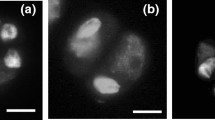Abstract
Three strains ofPenicillium chrysogenum selected for high penicillin yield and of independent lineage were marked with suitable genetical characters prior to the synthesis of several heterozygous diploids. These parental strains had domestic codes, C, D and Y. Two diploids, between differently labelled mutants of strain C and Y, produced similar amounts of penicillin to strain C, which was less than that produced by strain Y. Previous work had indicated that genes responsible for increased penicillin yield were recessive and the present results suggested that such genes in strains C and Y were allelic, apart from the presence of one or more additional recessive mutations leading to greater penicillin production in the higher yielding parent. Three diploids made between mutants of strains D and Y were lower in penicillin yield than either original parent and only in the case of one diploid compared with one of the parental strains was this difference not significant. In strains D and Y, therefore, there may have been some recessive genes concerned with increasing penicillin yield which were non-allelic. However, no first order segregants arising spontaneously or subsequent to X-ray treatment produced higher levels of penicillin than the better yielding original parent in any cross.
Similar content being viewed by others
References
Alikhanian, S. I. 1962. Induced mutagenesis in the selection of microorganisms. Advan. Appl. Microbiol.4: 1–50.
Backus, M. P. andStauffer, J. F. 1955. The production and selection of a family of strains inPenicillium chrysogenum. Mycologia47: 429–463.
Benzer, S. 1956. The elementary units of heredity, p. 70–93.In W. D. McElroy and B. Glass, [ed.], The chemical basis of heredity (Symposium). The Johns Hopkins Press, Baltimore, 1957.
Fratello, B., Morpurgo, G. andSermonti, G. 1960. Induced somatic segregation inAspergillus nidulans. Genetics45: 785–800.
Käfer, E. 1960. High frequency of spontaneous and induced somatic segregation inAspergillus nidulans. Nature186: 619–620.
Macdonald, K. D., Hutchinson, J. M. andGillett, W. A. 1963a. Isolation of auxotrophs ofPenicillium chrysogenum and their penicillin yields. J. Gen. Microbiol.33: 365–374.
Macdonald, K. D., Hutchinson, J. M. andGillett, W. A. 1963b. Heterokaryon studies and the genetic control of penicillin and chrysogenin production inPenicillium chrysogenum. J. Gen. Microbiol.33: 375–383.
Macdonald, K. D., Hutchinson, J. M. andGillett, W. A. 1963c. Formation and segregation of heterozygous diploids between a wild-type strain and derivatives of high penicillin yield inPenicillium chrysogenum. J. Gen. Microbiol.33: 385–394.
Pontecorvo, G. 1959. Trends in genetic analysis. Oxford University Press, London.
Pontecorvo, G. andRoper, J. A. 1952. Genetical analysis without sexual reproduction by means of polyploidy inAspergillus nidulans. J. Gen. Microbiol.6: vii-viii.
Pontecorvo, G. andSermonti, G. 1953. Recombination without sexual reproduction inPenicillium chrysogenum. Nature172: 126–127.
Pontecorvo, G., Tarr Gloor, E. andForbes, E. 1954. Analysis of mitotic recombination inAspergillus nidulans. J. Genet.52: 226–237.
Sermonti, G. 1957. Analysis of vegetative segregation and recombination inPenicillium chrysogenum. Genetics42: 433–443.
Sermonti, G. 1959. Genetics of penicillin production. Ann. N.Y. Acad. Sci.81: 950–973.
Sermonti, G. 1961. Panel discussion: Microbial genetics and its application to fermentations. Sci. Rept. Ist. Super. Sanità1: 462.
Sermonti, G. andMorpurgo, G. 1959. Genetics ofPenicillium chrysogenum. IV. Effects of certain mutagenic agents on somatic segregation from heterozygous diploids. Selected Sci. Papers Ist. Super. Sanità2: 416–426.
Stauffer, J. F. 1961. The use of ultraviolet radiation for mutations in antibiotic producing fungi. Sci. Rept. Ist. Super. Sanità1: 472–483.
Tector, M. A. andKäfer, E. 1962. Radiation-induced chromosomal aberrations and lethals inAspergillus nidulans. Science136: 1056–1057.
Author information
Authors and Affiliations
Rights and permissions
About this article
Cite this article
Macdonald, K.D., Hutchinson, J.M. & Gillett, W.A. Properties of heterozygous diploids between strains ofPenicillium chrysogenum selected for high penicillin yield. Antonie van Leeuwenhoek 30, 209–224 (1964). https://doi.org/10.1007/BF02046727
Received:
Issue Date:
DOI: https://doi.org/10.1007/BF02046727




